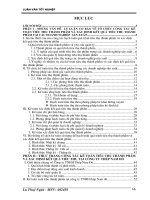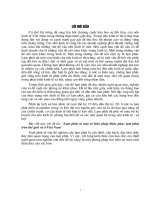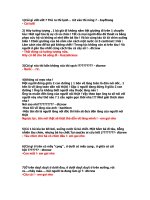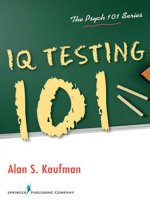Phát trển IQ - MORE IQ TESTING
Bạn đang xem bản rút gọn của tài liệu. Xem và tải ngay bản đầy đủ của tài liệu tại đây (441.35 KB, 26 trang )
The IQ Workout Series
MORE IQ TESTING
250 new ways to release your IQ potential
Philip Carter and Ken Russell
521pre.qxd 05/07/02 11:36 Page i
Copyright © 2002 by Philip Carter and Ken Russell
Published 2002 by John Wiley & Sons Ltd,
Baffins Lane, Chichester,
West Sussex PO19 1UD, England
National 01243 779777
International (+44) 1243 779777
e-mail (for orders and customer service enquiries):
Visit our Home Page on
or
Philip Carter and Ken Russell have asserted their right under the Copyright, Designs
and Patents Act, 1988, to be identified as the authors of this work.
All Rights Reserved. No part of this publication may be reproduced, stored in a
retrieval system, or transmitted, in any form or by any means, electronic,
mechanical, photocopying, recording, scanning or otherwise, except under the
terms of the Copyright, Designs and Patents Act 1988 or under the terms of a
licence issued by the Copyright Licensing Agency, 90 Tottenham Court Road,
London, UK W1P 9HE, without the permission in writing of the publisher and the
copyright holder.
Other Wiley Editorial Offices
John Wiley & Sons, Inc., 605 Third Avenue,
New York, NY 10158-0012, USA
WILEY-VCH Verlag GmbH, Pappelallee 3,
D-69469 Weinheim, Germany
John Wiley & Sons Australia Ltd, 33 Park Road, Milton,
Queensland 4064, Australia
John Wiley & Sons (Asia) Pte Ltd, 2 Clementi Loop #02-01,
Jin Xing Distripark, Singapore 129809
John Wiley & Sons (Canada) Ltd, 22 Worcester Road,
Rexdale, Ontario M9W 1L1, Canada
British Library Cataloguing in Publication Data
A catalogue record for this book is available from the British Library
ISBN 0-470-84717-4
Typeset in 11/14 pt Garamond Book by Dorwyn Ltd, Rowlands Castle, Hants.
Printed and bound in Great Britain by Biddles Ltd, Guildford and King’s Lynn.
This book is printed on acid-free paper responsibly manufactured from sustainable
forestry, in which at least two trees are planted for each one used for paper
production.
521pre.qxd 05/07/02 11:36 Page ii
Contents
Introduction 1
Part one 5
Visual analogy test 5
Visual odd one out test 19
Lateral thinking test 29
Which letter comes next 37
Visual sequence test 40
Numerical calculation test 49
Part two 53
IQ test one 53
IQ test two 67
IQ test three 79
IQ test four 88
IQ test five 101
IQ test six 113
IQ test seven 126
Answers 139
521pre.qxd 05/07/02 11:36 Page iii
521pre.qxd 05/07/02 11:36 Page iv
Introduction
Intelligence is the capacity to learn or understand. Although
intelligence is possessed by all people, it varies in amount for
each person, and remains the same throughout life from
approximately 18 years of age.
In psychology, intelligence is defined as the capacity to
acquire knowledge or understanding, and to use it in novel
situations.
What is IQ?
IQ is the abbreviation for intelligence quotient.
Intelligence quotient (IQ) is an age-related measure of
intelligence and is defined as 100 times mental age. The word
‘quotient’ means the result of dividing one quantity by
another, and intelligence can be defined as mental ability and
quickness of mind.
What is an IQ test?
IQ tests are part of what is generally referred to as
‘psychological testing’. Such test content may be addressed to
almost any aspect of our intellectual or emotional make-up,
including personality, attitude, intelligence or emotion.
An intelligence test (IQ test) is, by definition, any test that
purports to measure intelligence. Generally such tests consist
521pre.qxd 05/07/02 11:36 Page 1
of a series of tasks, each of which has been standardized with
a large representative population of individuals. Such a
procedure establishes the average IQ as 100.
When measuring the IQ of a child, that child is given an
intelligence test that has already been given to thousands of
other children, so that an average score has been established
for each age group. Thus, a child who at 8 years of age
obtained a result expected of a 10-year-old would score an IQ
of 125, that figure being mental age divided by chronological
age ן 100, or 10/8 ן 100. On the other hand, a child of 10
years of age who obtained a result expected of an 8-year-old
would score an IQ of 80, or 8/10 ן 100.
Because mental age remains constant from the age of 18
this method of calculation does not apply to adults. Adults
have, instead, to be judged on a standardized IQ test whose
average score is 100, and the results graded above and below
this score according to known scores.
Culture-fair IQ testing
As mastery of words is seen by many as the true measure of
intelligence, vocabulary tests have been widely used in
intelligence testing. Today, however, there is also a swing
towards diagrammatic tests where logic is more important
than word knowledge. Advocates of such non-verbal tests
argue that diagrammatic tests examine raw intelligence
without the influence of prior knowledge.
Such tests are referred to as culture-fair tests, or culture-free
tests, and are designed to be free of any particular cultural
bias so that no advantage is derived by individuals of one
culture relative to those of another. In other words, they
eliminate language factors or other skills that may be closely
tied to another culture.
2 More IQ Testing
521pre.qxd 05/07/02 11:36 Page 2
How to use this book
The tests in this book are culture-fair and rely mainly on
diagrammatical representation. However, numerical skill is
also tested as numbers are international and, in the same way
as diagrammatic representation, they test powers of logic, and
your ability to deal with problems in a structured and
analytical way.
The questions in this book are also designed to make you
think laterally and creatively, and the developing of such skills
can also prove invaluable in dealing with the many real-life
problems that you may encounter. They will also provide
valuable practice for readers who may have to take an IQ test
in the future.
Because the tests have been specially compiled for this
book they have not been standardized; therefore, an actual IQ
rating cannot be provided. We do, however, provide a guide
to assessing your performance on each of the separate tests.
The tests in the book are divided into two main sections. In
Part one we provide six separate tests, each of which test a
particular type of discipline. A time limit of 60 minutes is
allowed for each of these six tests.
In Part two we provide seven complete IQ tests, which bring
together each of these disciplines. A time limit of 80 minutes
is allowed for each of these seven tests.
We would recommend that you attempt the six tests in Part
one first as this will then provide practice on the type of
questions you are likely to encounter in Part two, which
should then enhance your performance on these seven
complete tests.
On all of the tests you have limited time, and this time limit
should be strictly adhered to, otherwise your score will be
invalidated. It is, therefore, important that you do not spend
too much time on any one question; if in doubt leave it and
Introduction 3
521pre.qxd 05/07/02 11:36 Page 3
return to it using the time remaining. If you do not know an
answer, it may be well worth while having an intuitive guess
as this may well prove to be correct.
Answers are provided for all questions together with
detailed explanations.
4 More IQ Testing
521pre.qxd 05/07/02 11:36 Page 4
Introduction
Intelligence is the capacity to learn or understand. Although
intelligence is possessed by all people, it varies in amount for
each person, and remains the same throughout life from
approximately 18 years of age.
In psychology, intelligence is defined as the capacity to
acquire knowledge or understanding, and to use it in novel
situations.
What is IQ?
IQ is the abbreviation for intelligence quotient.
Intelligence quotient (IQ) is an age-related measure of
intelligence and is defined as 100 times mental age. The word
‘quotient’ means the result of dividing one quantity by
another, and intelligence can be defined as mental ability and
quickness of mind.
What is an IQ test?
IQ tests are part of what is generally referred to as
‘psychological testing’. Such test content may be addressed to
almost any aspect of our intellectual or emotional make-up,
including personality, attitude, intelligence or emotion.
An intelligence test (IQ test) is, by definition, any test that
purports to measure intelligence. Generally such tests consist
521pre.qxd 05/07/02 11:31 Page 1
of a series of tasks, each of which has been standardized with
a large representative population of individuals. Such a
procedure establishes the average IQ as 100.
When measuring the IQ of a child, that child is given an
intelligence test that has already been given to thousands of
other children, so that an average score has been established
for each age group. Thus, a child who at 8 years of age
obtained a result expected of a 10-year-old would score an IQ
of 125, that figure being mental age divided by chronological
age ן 100, or 10/8 ן 100. On the other hand, a child of 10
years of age who obtained a result expected of an 8-year-old
would score an IQ of 80, or 8/10 ן 100.
Because mental age remains constant from the age of 18
this method of calculation does not apply to adults. Adults
have, instead, to be judged on a standardized IQ test whose
average score is 100, and the results graded above and below
this score according to known scores.
Culture-fair IQ testing
As mastery of words is seen by many as the true measure of
intelligence, vocabulary tests have been widely used in
intelligence testing. Today, however, there is also a swing
towards diagrammatic tests where logic is more important
than word knowledge. Advocates of such non-verbal tests
argue that diagrammatic tests examine raw intelligence
without the influence of prior knowledge.
Such tests are referred to as culture-fair tests, or culture-free
tests, and are designed to be free of any particular cultural
bias so that no advantage is derived by individuals of one
culture relative to those of another. In other words, they
eliminate language factors or other skills that may be closely
tied to another culture.
2 More IQ Testing
521pre.qxd 05/07/02 11:31 Page 2
How to use this book
The tests in this book are culture-fair and rely mainly on
diagrammatical representation. However, numerical skill is
also tested as numbers are international and, in the same way
as diagrammatic representation, they test powers of logic, and
your ability to deal with problems in a structured and
analytical way.
The questions in this book are also designed to make you
think laterally and creatively, and the developing of such skills
can also prove invaluable in dealing with the many real-life
problems that you may encounter. They will also provide
valuable practice for readers who may have to take an IQ test
in the future.
Because the tests have been specially compiled for this
book they have not been standardized; therefore, an actual IQ
rating cannot be provided. We do, however, provide a guide
to assessing your performance on each of the separate tests.
The tests in the book are divided into two main sections. In
Part one we provide six separate tests, each of which test a
particular type of discipline. A time limit of 60 minutes is
allowed for each of these six tests.
In Part two we provide seven complete IQ tests, which bring
together each of these disciplines. A time limit of 80 minutes
is allowed for each of these seven tests.
We would recommend that you attempt the six tests in Part
one first as this will then provide practice on the type of
questions you are likely to encounter in Part two, which
should then enhance your performance on these seven
complete tests.
On all of the tests you have limited time, and this time limit
should be strictly adhered to, otherwise your score will be
invalidated. It is, therefore, important that you do not spend
too much time on any one question; if in doubt leave it and
Introduction 3
521pre.qxd 05/07/02 11:31 Page 3
return to it using the time remaining. If you do not know an
answer, it may be well worth while having an intuitive guess
as this may well prove to be correct.
Answers are provided for all questions together with
detailed explanations.
4 More IQ Testing
521pre.qxd 05/07/02 11:31 Page 4
Part one
Visual analogy test
1
is to
as
is to
A B C D
E F G H
521ch1.qxd 05/07/02 11:29 Page 5
6 More IQ Testing
2
is to
as
is to
A B C D
E F G H
521ch1.qxd 05/07/02 11:29 Page 6
Visual Analogy Test 7
3
is to
as
is to
A
B
C
D
E
521ch1.qxd 05/07/02 11:29 Page 7
8 More IQ Testing
A
B
C
D
E
4
is to
as is to
521ch1.qxd 05/07/02 11:29 Page 8
A B C
D E
Visual Analogy Test 9
5
is to
as
is to
521ch1.qxd 05/07/02 11:29 Page 9
10 More IQ Testing
6
is to
as
is to
A B C
D E
521ch1.qxd 05/07/02 11:29 Page 10
A
B
C
D
E
Visual Analogy Test 11
7
is to
as is to
521ch1.qxd 05/07/02 11:29 Page 11
A B C
D E
8
is to
as
is to
12 More IQ Testing
521ch1.qxd 05/07/02 11:29 Page 12
9
is to
as
is to
Visual Analogy Test 13
A
B
C
D
E
521ch1.qxd 05/07/02 11:29 Page 13
10
is to
as
is to
14 More IQ Testing
A B C D E
521ch1.qxd 05/07/02 11:29 Page 14
11
is to
as
is to
Visual Analogy Test 15
521ch1.qxd 05/07/02 11:29 Page 15
12
is to
as is to
16 More IQ Testing
A
B
C
521ch1.qxd 05/07/02 11:29 Page 16
13
is to
as is to
Visual Analogy Test 17
A
B
C
D
521ch1.qxd 05/07/02 11:29 Page 17








